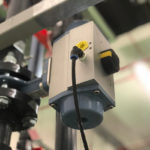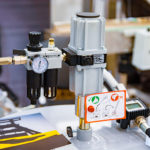By Justin Fluegel, Contributor
Electropneumatic pressure regulators are commonly used to control the force, tension or torque output of an actuator in a machine. These are found in a wide range of applications from custom machinery, food processing, semiconductors, cyclic testing machinery, and welding applications. The breadth of opportunities is vast for this technology, given the amount of machinery powered by pneumatics or that have a secondary pneumatic system supporting ancillary systems within a machine. Although you might expect to see them on nearly any machine, designers sometimes favor fully electric systems or choose not to incur the costs associated with the installation of new pneumatic infrastructure.
Let’s take a common challenge within two different machines.

In the image above, a spool of wire is fed into a machine. The pneumatic cylinders are being used to apply pressure on the shaft and function as a brake to keep the spool from unraveling the wire. This is a very simple circuit with a pressure relief valve limiting or a pressure regular controlling the pressure, a directional valve, and the cylinder. It’s a cost effective and simple method to control the spool.
There is one variable not accounted for in the control of the braking system — weight of the spool over time. When the spool is filled with wire, the inertia is high and only a small amount of braking force is required. As the wire is consumed the spool is lighter and prone to spin freer as the force of the clamping cylinder cannot be increased. If the consistency of feeding the wire must be consistent for the entirety of the spool feeding, an electropneumatic pressure regulator would allow the braking force of the cylinder to be adjusted as the weight on the spool diminishes.
Conveyors offer another application for a proportional pressure relief valve. A conveyor belt is driven by a pulley, which is rotating under the conveyor belt. The force of the pulley applied to the belt generates the friction to pull items on the belt. This is traditionally accomplished with a simple solution of a threaded rod to manually apply tension. As the belt stretches or load on the belt changes, the pulley requires adjustment. Given increased demand on conveyors, utilizing pneumatic cylinders and a proportional pressure regulator provides a company with a more adaptive and intelligent option. A rotary encoder installed on the belt surface provides the signal to the proportional pressure relief. As the belt speed slows due to natural stretch of the belt’s change in loading, the proportional pressure regulator can increase the pressure to the cylinder — extending to increase the tension on the belt. As manufacturing enters the internet of things (IoT), the conveyor can then signal when belt replacement is near — assisting with scheduled line downtime.
The example used shows that the question of when to utilize the advantages of the electropneumatic pressure control is really answered by the amount of control required over the system. In the example used, the additional cost of the valve and feedback system could be justified on the improved utilization of the machine or reduction in rejected parts by the machine.






Leave a Reply